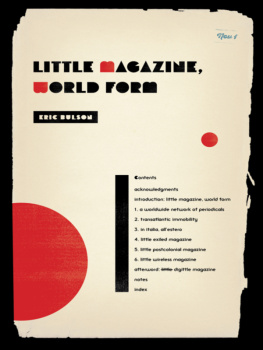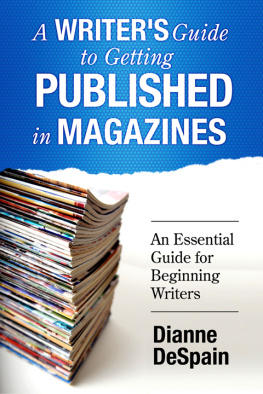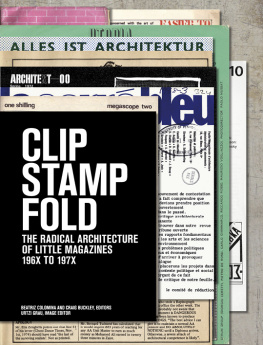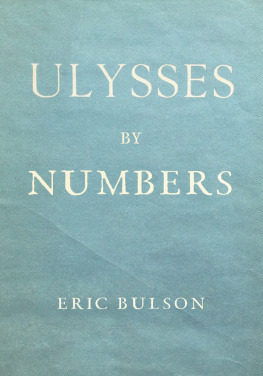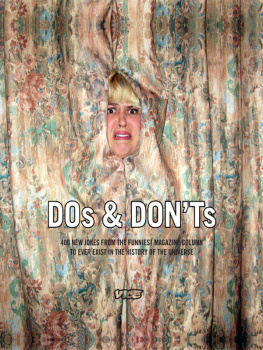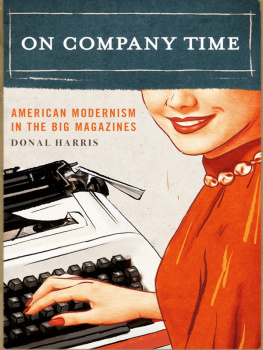Table of Contents
LITTLE M AGAZINE,W ORLD FORM
modernist latitudes
modernist latitudes
Jessica Berman and Paul Saint-Amour, Editors
MODERNIST LATITUDES aims to capture the energy and ferment of modernist studies by continuing to open up the range of forms, locations, temporalities, and theoretical approaches encompassed by the field.
The series celebrates the growing latitude (scope for freedom of action or thought") that this broadening affords scholars of modernism, whether they are investigating little-known works or revisiting canonical ones. Modernist Latitudes will pay particular attention to the texts and contexts of those latitudes (Africa, Latin America, Australia, Asia, Southern Europe, and even the rural United States) that have long been misrecognized as ancillary to the canonical modernisms of the global North.
Barry McCrea, In the Company of Strangers: Family and Narrative in Dickens, Conan Doyle, Joyce, and Proust, 2011
Jessica Berman, Modernist Commitments: Ethics, Politics, and Transnational Modernism, 2011
Jennifer Scappettone, Killing the Moonlight: Modernism in Venice, 2014
Nico Israel, Spirals: The Whirled Image in Twentieth-Century Literature and Art, 2015
Carrie Noland, Voices of Negritude in Modernist Print: Aesthetic Subjectivity, Diaspora, and the Lyric Regime, 2015
Susan Stanford Friedman, Planetary Modernisms: Provocations on Modernity Across Time, 2015
Steven S. Lee, The Ethnic Avant-Garde: Minority Cultures and World Revolution, 2015
Thomas S. Davis, The Extinct Scene: Late Modernism and Everyday Life, 2016
Carrie J. Preston, Learning to Kneel: Noh, Modernism, and Journeys in Teaching, 2016
Gayle Rogers, Incomparable Empires: Modernism and the Translation of Spanish and American Literature, 2016
Celia Marshik, At the Mercy of Their Clothes: Modernism, the Middlebrow, and British Garment Culture, 2016
Christopher Reed, Bachelor Japanists: Japanese Aesthetics and Western Masculinities, 2016
Donal Harris, On Company Time: American Modernism in the Big Magazines, 2016
Eric Hayot and Rebecca L. Walkowitz, eds., A New Vocabulary for Global Modernism, 2016
LITTLE M AGAZINE,W ORLD FORM
ERIC BULSON
COLUMBIA UNIVERSITY PRESS
NEW YORK
Columbia University Press
Publishers Since 1893
New York Chichester, West Sussex
cup.columbia.edu
Copyright 2017 Columbia University Press
All rights reserved
E-ISBN 978-0-231-54232-6
ISBN 978-0-231-17976-8 (cloth: alk. paper)
ISBN 978-0-231-54232-6 (ebook)
LCCN 2016026233
Cataloging-in-Publication data is on file with the Library of Congress.
A Columbia University Press E-book.
CUP would be pleased to hear about your reading experience with this e-book at .
Jacket design: Nancy Rouemy
Book design: Lisa Hamm
for the three loves of my life:
leif,
finn,
&
mika
contents
I WAS FASCINATED by little magazines long before I had any intention of writing about them. If I had to pinpoint a moment when this fascination turned into something more like scholarly interest, it would have to be the fall of 1998, when I was enrolled in Jonathan Levins seminar on modernist poetry. For one of the assignments that semester, we had to pick a little magazine title, track down the collection at the New York Public Library, and report back on what we found. Along with serious admiration for the poems of Mina Loy, whom I had never heard of before then, and enormous gratitude to Jonathan for sending me there, I returned with something else: a passion for little magazines. The experience of handling a single issue felt like time travel, and though I had never quite thought much about it before, there was something to be learned from what these pages and covers were made of and how they were designed and colored. Figuring out just what that something was would take time, more than I anticipated, but as is true with everything else in life, you have to start somewhere.
For the countless hours of feedback, encouragement, intellectual exchange, and everything else, I am grateful to my dear friend Kent Puckett, someone I could always count on when thinking and writing about all things little grew tiresome. Joe Keith was another reliable supporter, and I benefited from his uncanny ability to tell me where I might find the big picture. Andreas Huyssen continues to remind me why any of this stuff matters to begin with, and I was lucky enough to have him read through early drafts of the pages that follow in the wilds of Woodstock and high up above Riverside Drive. And where would I be without Jean-Michel Rabat? During the middle stage in this process, he generously agreed to read the chapters I had finished, giving valuable advice about how to map out the terrain ahead. At a much later stage, I was fortunate to have Roger Conover read and comment on the entire manuscript. His incredibly detailed report was formative during the revision process, and it made me realize that the intellectual interest in little magazines may be interdisciplinary, but the kinds of conversations it inspires are not everywhere the same.
And then there were always others: more friends, colleagues, acquaintances, and students. Included among them are Edi Giunta, for getting me interested in all of this to begin with and then continuing to provide her love and translation advice; Rob Carson, for telling me all about cats, and David Weiss, for building a castle; Kevin Dettmar, for patiently listening to me talk on and on and on; Mark Wollaeger, for asking me to contribute to The Oxford Handbook of Global Modernisms; Peter Brooker, Andrew Thacker, and Sascha Bru, for including me in the third volume of their Oxford Critical and Cultural History of Modernist Magazines series; Sarah Cole, for providing crucial advice about framing and delivery; Effie Rentzhou and Joshua Kotin, for inviting me to their avant-gardes seminar at Princeton to talk about wireless magazines; the members of my little magazines seminar at Claremont Graduate University (Jacob Aplaca, Kristen Brownell, Francesca Gacho, Katrina Kass, Bridget OReilly, Michael Bishop, and Jacqueline Piros), for their own infectious enthusiasm with this material; to Warren Roberts, for making those Futurist maps come alive; and, finally, to my research assistant, April Anderson, for her incredible patience, diligence, and keen critical eye, the things that were needed to get this manuscript ready for publication.
And where would I be without the libraries and archives? Included among them are the Division of Archives and Manuscripts and the Berg Collection at the New York Public Library, the Museum of Modern Art Library, the Beinecke Rare Book and Manuscript Library at Yale, Princeton Universitys Archives and Manuscripts, the Getty Research Institute Library, the Rare Book and Manuscript Library at Columbia University, the Wolfsonian, the Poetry-Rare Books Collection at the University of Buffalo, the Fondazione Arnoldo e Alberto Mondadori in Milan, and the British Library. There are also the online digital collections I have relied on heavily, including the Catologo Informatico Riviste Culturali Europee from the University of Trento, the Modernist Journals Project at Brown University, the International Dada Archive at University of Iowa, Gallica at the Bibliothque nationale de France, Hemeroteca Digital at the Biblioteca Nacional de Espaa, the Digital National Library of Serbia, Monoskop, UbuWeb, and the Princeton Blue Mountain Collection.

